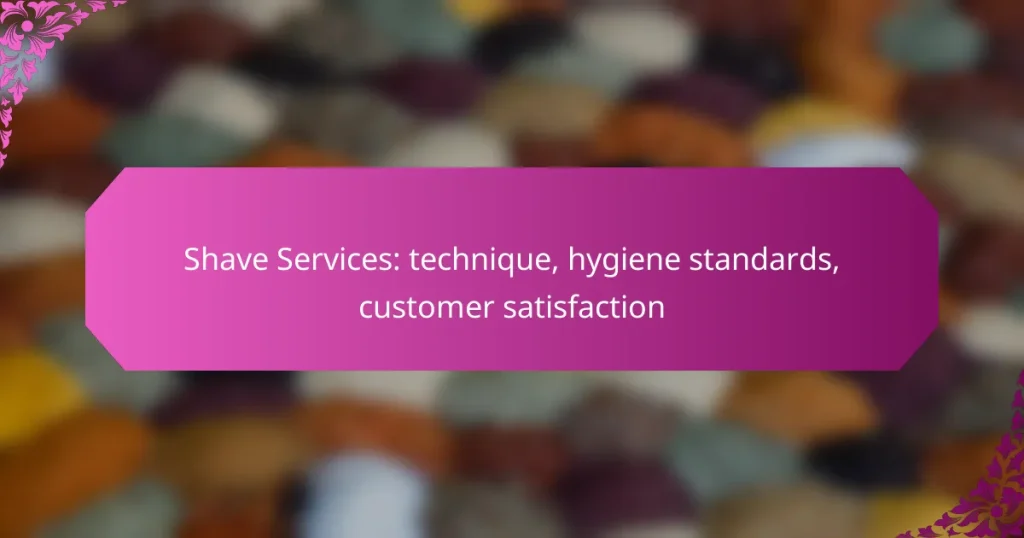Shave services offer a range of experiences, from traditional barber shops to luxury spas, each designed to meet diverse customer preferences. The techniques employed can vary significantly, affecting both the closeness of the shave and overall satisfaction. Maintaining high hygiene standards is essential in these services, ensuring safety through rigorous sanitation protocols and equipment sterilization.

What are the best shave services in Los Angeles?
The best shave services in Los Angeles include barber shops, mobile shave services, and luxury spas, each offering unique experiences tailored to different preferences. Choosing the right service depends on factors like convenience, quality, and personal style.
Barber shops
Barber shops in Los Angeles are known for their traditional and skilled shaving techniques. Many barbers use straight razors, providing a close shave while also offering a classic grooming experience.
When selecting a barber shop, consider the shop’s reputation, customer reviews, and the expertise of the barbers. Prices typically range from $20 to $50, depending on the service and location.
Mobile shave services
Mobile shave services bring the barber experience directly to your location, offering convenience for busy individuals. These services often include a full range of grooming options, from basic shaves to more elaborate treatments.
When booking a mobile shave, check the service provider’s hygiene standards and customer feedback. Prices can vary widely, generally falling between $30 and $100, depending on the complexity of the service and travel distance.
Luxury spas
Luxury spas in Los Angeles offer high-end shave services that often include additional pampering, such as skin treatments and massages. These services focus on relaxation and skin care, providing a premium experience.
Expect to pay more at luxury spas, with prices typically starting around $75 and going up to $150 or more for comprehensive packages. Look for spas that emphasize hygiene and customer satisfaction to ensure a top-notch experience.

How do shave techniques vary?
Shave techniques differ primarily in the tools used and the resulting closeness of the shave. Each method has its own advantages and considerations, impacting the overall experience and satisfaction.
Traditional straight razor
The traditional straight razor offers a very close shave, often preferred by those seeking precision. This technique requires skill and practice to master, as it involves using a single, sharp blade that glides over the skin.
To achieve the best results, it’s crucial to prepare the skin properly with warm water and shaving cream. Regular honing and stropping of the blade are necessary to maintain sharpness and prevent nicks.
Common pitfalls include applying too much pressure and shaving against the grain, which can lead to irritation. A steady hand and patience are essential for a successful shave.
Safety razor
A safety razor is designed to minimize the risk of cuts while still providing a close shave. It features a protective guard that helps control the blade’s angle and exposure, making it a popular choice for beginners.
When using a safety razor, it’s important to choose the right blade for your skin type and hair thickness. Shaving with the grain and using light pressure can enhance comfort and reduce irritation.
Replacing blades regularly is key to maintaining performance. Many users find that a good safety razor can last for years, making it a cost-effective option in the long run.
Electric shaver
Electric shavers offer convenience and speed, making them ideal for those with busy lifestyles. They come in two main types: rotary and foil, each with its own shaving mechanism and user experience.
Rotary shavers typically excel in contouring to the face’s curves, while foil shavers provide a closer shave on flat surfaces. Choosing the right type depends on personal preference and skin sensitivity.
For optimal results, ensure the shaver is clean and well-maintained. Regularly replacing the blades or foils is essential for achieving a smooth shave without irritation. Electric shavers are generally less suited for intricate styles or very close shaves compared to traditional methods.

What hygiene standards are followed in shave services?
Hygiene standards in shave services are critical for ensuring customer safety and satisfaction. These standards encompass sanitation protocols, equipment sterilization, and the use of personal protective equipment to minimize the risk of infections and maintain a clean environment.
Sanitation protocols
Sanitation protocols involve thorough cleaning procedures for the shaving area and tools. Surfaces should be wiped down with disinfectants before and after each service to eliminate bacteria and viruses. Regular cleaning schedules should be established to ensure compliance with hygiene standards.
Additionally, barbers and stylists should wash their hands before and after each shave, using antibacterial soap. This practice helps prevent the transfer of germs and enhances overall customer safety.
Equipment sterilization
Equipment sterilization is essential in shave services to prevent cross-contamination. Tools such as razors, scissors, and combs should be sterilized using methods like autoclaving or soaking in disinfectant solutions between uses. This ensures that all equipment is free from pathogens before coming into contact with a customer’s skin.
It is advisable for establishments to keep a log of sterilization processes to maintain accountability and demonstrate compliance with health regulations. Regular inspections can help ensure that these practices are consistently followed.
Personal protective equipment
Personal protective equipment (PPE) is vital for both the service provider and the customer. Barbers should wear gloves during the shaving process to protect against bloodborne pathogens and other contaminants. Masks may also be recommended, especially in environments where close contact is unavoidable.
Customers should be informed about the use of PPE and its importance in maintaining hygiene standards. This transparency can enhance customer confidence and satisfaction, leading to a more positive experience overall.

How is customer satisfaction measured in shave services?
Customer satisfaction in shave services is typically assessed through various methods that capture client experiences and preferences. Key metrics include feedback surveys, online reviews, and the rate of repeat business, each providing insights into service quality and client loyalty.
Client feedback surveys
Client feedback surveys are a direct way to gauge satisfaction levels after a shave service. These surveys often include questions about the quality of the shave, the professionalism of the staff, and the overall atmosphere of the establishment.
To maximize effectiveness, surveys should be concise and easy to complete, ideally taking no more than a few minutes. Offering incentives, such as discounts on future services, can increase participation rates.
Online reviews
Online reviews play a significant role in shaping customer perceptions of shave services. Platforms like Google, Yelp, and social media allow clients to share their experiences, which can influence potential customers’ decisions.
Monitoring these reviews is crucial for businesses. Responding to feedback—both positive and negative—demonstrates a commitment to customer satisfaction and can help address any issues that arise.
Repeat business rates
The rate of repeat business is a strong indicator of customer satisfaction in shave services. A high percentage of returning clients suggests that customers are pleased with their experiences and trust the service provider.
To encourage repeat visits, businesses can implement loyalty programs or offer package deals. Tracking these rates over time can help identify trends and areas for improvement in service delivery.

What are the prerequisites for a quality shave service?
Quality shave services require trained professionals, quality products, and a clean environment. These factors ensure a safe, effective, and satisfying experience for customers.
Trained professionals
Trained professionals are essential for delivering a quality shave service. They possess the skills and knowledge to use shaving tools effectively, minimizing the risk of cuts or irritation. Look for barbers or stylists who have completed accredited training programs or apprenticeships.
Experience also matters; seasoned professionals often have a better understanding of different skin types and hair textures, allowing them to tailor their techniques accordingly. Always check for customer reviews or ask for recommendations to find skilled barbers in your area.
Quality products
Using quality products is crucial for achieving a smooth shave. High-grade razors, shaving creams, and aftershaves can significantly enhance the shaving experience by reducing friction and irritation. Opt for products that are suitable for your skin type, whether sensitive, oily, or dry.
Many barbershops offer premium brands that are not commonly found in retail stores. Don’t hesitate to ask your barber about the products they use and their benefits, as this can help you make informed choices for at-home shaving as well.
Clean environment
A clean environment is vital for any shave service to ensure hygiene and customer safety. Barbershops should adhere to strict sanitation practices, including sterilizing tools and maintaining a tidy workspace. Look for establishments that visibly prioritize cleanliness.
Additionally, check if the barbershop follows local health regulations regarding sanitation. A well-maintained environment not only enhances your comfort but also reduces the risk of infections or skin irritations.

How do shave services ensure safety for clients?
Shave services prioritize client safety through strict hygiene practices and thorough assessments. These measures help prevent skin irritations and allergic reactions, ensuring a comfortable experience.
Skin assessments
Skin assessments involve evaluating the client’s skin type and condition before any shaving procedure. This step helps identify any sensitivities or pre-existing conditions that could affect the shaving process.
During a skin assessment, professionals may look for signs of irritation, dryness, or other skin issues. Clients with sensitive skin may require special techniques or products to minimize discomfort.
Allergy testing
Allergy testing is a crucial part of ensuring safety in shave services. This process typically involves applying a small amount of shaving product to a discreet area of the skin to check for adverse reactions.
Clients should be informed about the ingredients in the products used. If a reaction occurs, alternative products can be selected to avoid discomfort or allergic responses during the shave.

